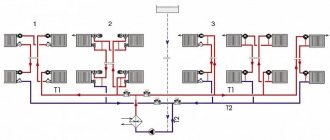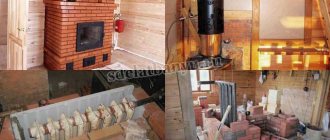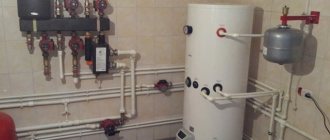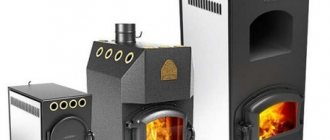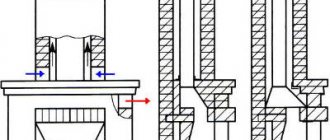We know that geothermy is the heat of the Earth, and the concept “geothermal” is often associated with volcanoes and geysers. In Russia, geothermal energy is used primarily on an industrial scale; for example, there are Far Eastern power plants that operate using the heat of our planet.
Many people are sure that making geothermal heating at home with their own hands is something out of science fiction. Is not it? But this is absolutely not true! With the development of modern technologies, the domestic use of “green energy” has become quite possible.
We will talk about the operating principles of alternative heating, its advantages and disadvantages, and compare it with traditional heating systems. You will also learn about how to position the heat exchanger and how to install geothermal heating with your own hands.
A few historical facts
When the oil crisis broke out in the 70s of the last century, a burning need for alternative energy sources arose in the West. It was at this time that the first geothermal heating systems began to be created.
Today they are widespread in the United States, Canada and Western European countries.
Image gallery
Photo from
Prospects for geothermal heating
Dimensions of the indoor unit of the geothermal system
Cost of installation and operation of a heat pump
Environmental priorities of heat pumps
For example, in Sweden they actively use water from the Baltic Sea, whose temperature is +4°C. In Germany, the introduction of geothermal heating systems is even sponsored at the state level.
When we mention geothermal energy sources, we always imagine a valley of geysers or volcanoes, but the sources we need are much closer. And they will help us stay warm in winter and cool in summer.
In Russia there are Pauzhetskaya, Verkhne-Mutnovskaya, Okeanskaya and other geothermal power plants. But there is very little evidence of the use of Earth's energy in our private sector.
Reviews about geothermal heating
How can you form an objective opinion about this type of heating? One way is to read in detail the reviews about geothermal heating at home. This must be done very carefully. Some system owners do not fully understand how geothermal heating works. That’s why there are negative reviews about its functioning:
- We have been considering the relevance of installing a heat pump for a long time. The system is expensive, but considering the electric heating of the house, it turned out to be a very productive cost-saving tool. It is irrational to use only geothermal heating - the water takes too long to heat up. Therefore, we use it as an auxiliary system;
- Installation of the heat pump with pipes took almost two weeks. As it turned out, it is impossible to build on the site where highways were laid. And they occupy a significant area of the yard. Now we are thinking about remodeling - we will drill wells and mount the external circuit in a new way;
- We were assured that the heat pump was capable of completely heating our rather large house - 230 m². But in winter, the water in the pipes barely heats up to +50°C. Therefore, you have to periodically turn on the backup electric boiler.
Is it worth installing geothermal heating, given the complexity of installation and the high cost of equipment? This must be a balanced decision, supported by calculations and a complete analysis of the entire system. Only on the basis of this data can the relevance of installing geothermal heating be determined.
A real review of the operation of geothermal heating can be found in the video:
About geothermal heating sources
The following sources of terrestrial thermal energy can be used for geothermal heating:
- high temperature;
- low temperature.
High-temperature ones include, for example, thermal springs. They can be used, but their scope is limited by the actual location of such sources.
While in Iceland this type of energy is actively used, in Russia thermal waters are located far from populated areas. They are concentrated to the maximum in Kamchatka, where underground water is used as a coolant and supplied to hot water systems.
To effectively use the earth's thermal energy, you do not need a volcano. It is enough to use those resources that are located just 200 meters from the earth’s surface
But we have all the necessary prerequisites for the use of low-temperature sources. The surrounding air masses, earth or water are suitable for this purpose.
A heat pump is used to extract the required energy. With its help, the procedure is carried out to convert the ambient temperature into thermal energy not only for heating, but also for hot water supply to a private household.
Image gallery
Photo from
Absorption of free heat from groundwater and rocks
External heat exchanger of the earth-water system
External heat exchanger in a natural reservoir
Geothermal Well Heat Pump
Two types of heat exchanger locations
There are two options for heating a private home using low-temperature energy from environmental elements. The basis of the system in all three cases is a geothermal pump.
The internal circuit remains unchanged for any heating method, and the main difference is the location of the external circuit.
Geothermal heating comes with a heat exchanger located:
- vertically – located in wells that penetrate or do not penetrate the aquifer;
- horizontally - the heat exchangers of the systems are placed in a pit or open reservoir in the form of a kind of coil.
Each of the types of heating listed here is characterized by its own characteristics, disadvantages and advantages.
If you intend to create such a heating system with your own hands, you will be interested in learning more about each type.
Option 1. Vertical placement of the external collector
This type of heating is based on an interesting natural phenomenon: at a depth of 50-100 m or more from its surface, the earth has the same and constant temperature of 10-12°C all year round.
To be able to use this earth energy, it is necessary to drill vertical wells. The technology is almost similar to the preparation of a water intake source.
In order to preserve the landscape as much as possible, several pipes can be drilled from the same starting point, but at different angles.
The external circuit of the system will be installed directly in these wells. This will allow you to effectively take away its heat from the earth. Of course, this method can hardly be called simple and low-budget.
To create a vertical geothermal heating system, you need to use equipment for drilling wells; without using a drilling rig, solving the problems of constructing the system will be quite labor-intensive (+)
It is relevant in the case when the territory adjacent to the house has already been developed, and disturbing its landscape is impractical. The depth of drilling a well can reach from 50 to 200 meters.
The specific parameters of the well depend on the geological situation at the site and the parameters of the future structure. The service life of this design is approximately 100 years.
To install a vertical version of the system with a heat exchanger that extracts the energy of underground water, you will need to drill two water-bearing wells.
From one of them, called the debit one, water is drawn using a pump, which, after heat transfer, is drained into the second, receiving outlet.
The disadvantage of a geothermal system with two wells is that it is not efficient enough to heat a country house. The circulation pump wastes too much energy. But to supply the coolant to the heated floor circuit, the resulting thermal energy is quite sufficient
Option #2. Horizontal arrangement of the soil collector
To lay the external circuit for horizontal heating, you need to know to what depth the ground freezes in your area.
The pipes are laid below the freezing level in pre-prepared trenches, covering a fairly large space: to heat a house with an area of 200-250 square meters. m, you need to use approximately 600 sq. m heat exchanger. That is six hundred square meters.
The disadvantage of this design is the large area it occupies. If you need a lawn covered with grass and flowers on your property, this is your option. It is better to keep collector pipes away from fruit-bearing trees (+)
It is clear that under such conditions, the volume of excavation work will be significant. In addition, you need to take into account the location of trees and other vegetation on the site in your plan so as not to freeze them. For example, collector pipes should not be located closer than one and a half meters from trees.
This installation method is used, as a rule, in cases where the site is just being developed for construction. All calculations and plans for building a cottage, organizing its heating and planning the land plot are best carried out simultaneously.
The operating principle of such heating
If you are familiar with how an air conditioner or refrigerator works, then the similarity of these processes with the principle of operation of geothermal heating is obvious. The basis of the system is a heat pump, which is connected to two circuits - external and internal.
To organize a traditional heating system in any house, it is necessary to install pipes for transporting coolant and radiators, when heated, heat will flow into the premises. In our case, pipes and radiators are also needed. They form the internal contour of the system. Warm floors can be added to the scheme.
The external contour looks much larger than the internal one, although its dimensions can only be assessed during planning and installation. During operation, it is invisible because it is underground or underwater. Plain water or ethylene glycol-based antifreeze circulates inside this circuit, which is much preferable.
The geothermal heating system includes two circuits - internal and external, as well as the heart of the heating system - a heat pump, which, by compressing the coolant, increases its temperature (+)
The coolant in the external circuit is heated to the state of the environment in which it is immersed and is sent in a “heated” form into a heat pump.
Through it, concentrated heat is transferred to the internal circuit, as a result of which the water in pipes, radiators and heated floors is heated. Thus, the key element that animates the entire system is the heat pump. If your home has an ordinary washing machine, then know: this pump will take up approximately the same area.
To operate, it needs electricity, but, consuming only 1 kW, it produces 4-5 kW of heat. And this is not a miracle, since the source of “additional” energy is known - this is the environment.
Advantages and disadvantages of geothermal heat pumps
There is little experience in mass and, most importantly, long-term operation of heat pumps in Russia. Users are divided into two opposing camps: those who praise the heating system (sellers and installers should also be included here) and opponents who are faced with operational difficulties or unscrupulous installation companies.
Based on the reviews, conclusions can be drawn about the advantages and disadvantages of heat pumps.
| Advantages | Flaws |
| Low power consumption, for 1 kW of electricity spent you get 2.5-3.5 kW (in reality) and up to 7 kW (ideally) of thermal power | Large financial investments at the design and installation stage |
| Possibility of installation in any area - depending on the region, ground, water or air external heat intake circuits are used | The need for additional heat sources at air temperatures below 25°C |
| Reversible - the system works for heating in winter and cooling in summer | Danger for soil microorganisms - the soil cools, bacteria die, soil fertility decreases |
| Versatile - can be used to heat a home, heat water for everyday needs or heat swimming pool water | The systems are effective only when equipped with a “warm floor” - the coolant heats up to 50°C, this is not enough for the radiators to operate efficiently |
| Durability - foreign experience speaks of 30-50 years of operation before equipment replacement | Low efficiency with a small temperature spread of the coolant in the external circuit and installation environment (soil, water) |
| Minimal maintenance costs | |
| Full process automation | |
| Environmental safety - no harmful emissions | |
| All you need is electricity to operate. |
The advantages are manifested in high-quality design, the correct choice of equipment, and compliance with installation rules.
Immersion of a horizontal heat exchanger in a reservoir
This method requires a special location of the household - at a distance of about 100 m from a reservoir of sufficient depth. In addition, the specified reservoir should not freeze to the very bottom, where the external contour of the system will be located. And for this, the area of the reservoir cannot be less than 200 square meters. m.
This option for placing a heat exchanger is considered the least expensive, but such an arrangement of households is still not common. In addition, difficulties may arise if the reservoir is a public property.
The obvious advantage of this method is the absence of mandatory labor-intensive excavation work, although you still have to tinker with the underwater location of the collector. And special permission to carry out such work will also be required.
However, a geothermal installation using water energy is still the most economical.
Prices
| Name | Price | Note |
| Radiator installation (open wiring) | from 4500 rub. | depending on quantity |
| Radiator installation (hidden wiring) | from 5000 rub. | — |
| Installation of external manifold cabinet | from 3500 rub. | |
| Installation of a built-in manifold cabinet | from 6000 rub. | |
| Installation of a wall-mounted double-circuit boiler | from 700 rub./kW | coaxial chimney no more than 1m |
| Installation of a wall-mounted double-circuit boiler with an indirect heating boiler | from 1000 rub./kW | — |
| Installation of a wall-mounted or floor-standing boiler with automation | from 1500 rub./kW | up to 6 direct or mixing circuits |
| Electric boiler installation | from 6000 rub. | |
| Installation of heated floors | from 500 rub./m2 |
Do it yourself: what and how
If you are going to install geothermal heating yourself, then it is better to buy the external circuit ready-made. Of course, we are only considering ways to horizontally position the external heat exchanger: under the surface of the soil or under water.
It is much more difficult to install a vertical well collector yourself if you do not have the equipment and drilling skills.
A heat pump is not a very large piece of equipment. It will not take up much space in your home. After all, in size it is comparable, for example, to a conventional solid fuel boiler. Connecting the internal circuit of your home to it is not a difficult task.
In fact, everything is done in exactly the same way as when organizing and distributing heating using traditional heat sources. The main difficulty is the design of the external circuit.
This arrangement of the house relative to the pond is more common. The main thing is that the reservoir is no further than 100 meters from the cottage
The best option would be to use a reservoir if one is found at a distance of no more than 100 m. It is necessary that its area exceed 200 sq. m. m, and the depth is 3 m (average freezing parameter). If this body of water does not belong to you, then obtaining permission to use it may become a problem.
If the reservoir is a pond that is on your property, then the matter becomes simpler. The water from the pond can be temporarily pumped out. Then work on its bottom can be done easily: you will need to lay the pipes in a spiral, securing them in this position.
Excavation work will only be needed to dig a trench, which will be needed to connect the external circuit to the heat pump.
After all work has been completed, the pond can be filled with water again. In the next hundred years, the external heat exchanger should work properly and not cause trouble to its owner.
If you have at your disposal a plot of land on which you just have to build housing and grow a garden, it makes sense to plan a horizontal ground-type heat exchanger.
To do this, you should make a preliminary calculation of the area of the future collector, based on the parameters already indicated above: 250-300 sq. m of collector per 100 sq. m of heated area of the house.
If you have a plot without buildings or vegetation that you would like to preserve, the soil can simply be removed when constructing an external horizontal soil contour: this is easier than digging trenches
The trenches in which the circuit pipes are to be laid must be dug below the soil freezing level.
Better yet, simply remove the soil to the depth of its freezing, lay the pipes, and then return the soil to its place. The work is labor-intensive and complex, but with great desire and determination, you can complete it.
Types by type of construction
Geothermal heating in a cottage works on a principle somewhat similar to a refrigerator. The main element here is a heat pump, which is switched on in two circuits simultaneously. The internal circuit is a traditional heating system consisting of piping and radiators. And the external one is a large heat exchanger, which is placed either under the water column or underground.
Typically, a liquid containing antifreeze circulates inside the heat exchanger. This kind of coolant takes on the temperature regime of the environment, which subsequently, already heated, goes to the heat pump. The previously accumulated heat goes into the internal circuit, after which the water in the pipes and radiators is heated.
Components of a geothermal heating system
Thus, turnkey geothermal heating of a house includes one most important element in the system - a heat pump. This is a compact device that takes up little space.
Needless to say, installation of such a system will also be expensive. Therefore, many owners of private and country houses decide to heat their private houses with the heat of the earth themselves.
First of all, it is necessary to take into account that there are three types of heat exchangers - horizontal, vertical and water-based.
Horizontal heat exchanger. This type is used quite often. When using it, pipes are placed in specially made trenches to a depth that is slightly higher than the freezing level of the soil cover in the area. However, this system has one drawback - it requires a large area to place the collector, and not everyone can afford such a design. And if there are trees on your territory, then the equipment should be placed at a distance of approximately 1.5 meters from them.
Geothermal heating system with horizontal heat exchanger
Vertical heat exchanger. Such a device is more compact, but at the same time more expensive. In order to equip your home with geothermal heating with such a device, you do not need a large area, but you will need drilling equipment. Indeed, in this case, the depth of the well must necessarily be from 50 to 200 meters. Note that this is the most expensive method, but it can last as long as 100 years! If you want to geoheat a house located outside the city, then the system is suitable. And the landscape remains untouched.
Geothermal heating system with vertical heat exchanger
Water-based heat exchanger. This type is the most economical, as it uses the heat of water. It is recommended to install the system at a distance from a body of water no more than 100 meters. The pipeline contour is laid on the bottom in the form of a spiral, and the depth should be no more than 3 meters. As for the reservoir, it is recommended that its area be at least 200 square meters. With such a system, labor-intensive work and permission are not required.
Ground to water heat pump
Thus, it can be noted that making geothermal heating of a country house yourself is quite difficult. However, you can implement your plan with at least one assistant. The third method is the best option, but there are several necessary points without which it will not work, and in particular, a pond.
Costs and payback prospects
The costs of equipment and its installation during the construction of geothermal heating depend on the power of the unit and the manufacturer.
Everyone chooses a manufacturer based on their own considerations and information about the reputation and reliability of a particular brand. But the power depends on the area of the room to be served.
This figure summarizes the benefits of using a geothermal heating system. It is precisely this ratio of incoming and outgoing energy that allows the system to first quickly pay for itself and then save its owner’s money (+)
If we take power into account, the cost of heat pumps varies in the following ranges:
- for 4-5 kW – 3000-7000 conventional units;
- for 5-10 kW – 4000-8000 conventional units;
- for 10-15 kW – 5000-10000 conventional units.
If we add to this amount the costs that are needed to carry out installation work (20-40%), then we will get an amount that for many will seem absolutely unrealistic.
But all these costs will be recouped in a very reasonable time frame. In the future, you will only have to pay minor expenses for the electricity needed to operate the pump. And it's all!
Due to the insufficient efficiency of geothermal systems for heating residential buildings, they are used as an addition to the main heating networks or built in complex with two or more heat exchangers
As practice shows, geothermal heating is especially beneficial for houses with a total heated area of 150 square meters. m. Within five to eight years, all costs for installing heating systems in these houses are fully recouped.
If geothermal heating is not particularly in demand among owners of private houses, then the effectiveness of solar systems has already been appreciated by residents of the southern regions. The technology for constructing solar heating is quite simple, and its efficiency and practicality are confirmed by many years of experience in use by Western countries and our compatriots.
More information about alternative energy sources is provided in this article.
How does it work?
The operating principle of geothermal heating involves the use of heat pumps. They operate according to the classical Carnot cycle, taking cold coolant deep below and receiving in return a fluid flow heated to 50 degrees inside the heating system. The equipment operates with an efficiency of 350 to 450% (this does not contradict the fundamental physical laws; why will be discussed later). A standard heat pump heats a house or other building using the heat of the earth for 100 thousand hours (this is the average interval between preventive major repairs).
Heating to 50 degrees was not chosen by chance. Based on the results of special calculations and the study of practically implemented systems, this indicator was recognized as the most effective. Therefore, earth heating, which uses the flow of energy from the subsoil, is mainly supplemented not by radiators, but by a warm floor or an air circuit. On average, for 1000 W of energy driving the pump, it is possible to raise approximately 3500 W of thermal energy to the top. Against the backdrop of the rampant increase in the cost of coolant in the main network and other heating methods, this is a very pleasant indicator.
Geothermal heating is formed by three circuits:
- ground collector;
- heat pump;
- actually, the heating complex of the house.
The reason is simple - the water that occurs in a sufficiently heated soil layer quickly corrodes the equipment. And even such a liquid can not be found in any random place. The choice of a specific coolant is determined by the design decisions of engineers. The pump is selected depending on the design of the remaining parts of the system. Since the depth of the well (level of installation of equipment) is determined by natural conditions, the decisive differences between types of geothermal systems are associated with the design of the collector in the ground.
The horizontal structure implies the location of the collector below the soil freezing line. Depending on the specific area, this means a deepening of 150-200 cm. Such collectors can be equipped with various pipes, both copper (with an outer layer of PVC) and those made of metal-plastic. To get from 7 to 9 kW of heat, you will have to lay at least 300 square meters. m collector. This technique does not allow you to get closer to the trees than 150 cm, and after installation is completed you will have to landscape the area.
A vertically aligned reservoir involves drilling several wells, necessarily directed in different directions, and each one is drilled at its own angle. Geothermal probes are located inside the wells, thermal output from 1 linear. m reaches approximately 50 W. It is easy to calculate that for an identical amount of heat (7-9 kW), 150-200 m of wells will have to be installed. The advantage in this case is not only in savings, but also in the fact that the landscape structure of the territory does not change. It will only be necessary to allocate a small area for the installation of the caisson block and for the installation of the concentrating collector.
A circuit heated by water is practical if it is possible to bring the external heat exchange unit into a lake or pond to a depth of 200 to 300 cm. But a mandatory condition will be the location of the reservoir within a radius of 0.1 km from the heated building and the area of the water surface at least 200 square meters. m. There are also air heat exchangers, when the external circuit receives heat from the atmosphere. This solution works well in the southern regions of the country and does not require any excavation work. The weaknesses of the system are low efficiency when the temperature drops to 15 degrees and a complete stop if the temperature drops to 20 degrees.
Conclusions and useful video on the topic
If it’s easier for you to perceive visual information, then this video will allow you to see with your own eyes exactly how a geothermal system functions, as well as learn more about who benefits from this type of heating and why.
We invite you to watch a short video in which the owner of a horizontal subsoil collector will talk about his impressions of its operation. Additionally, by watching this video, you will learn about the ongoing costs associated with operating a geothermal heating system.
Each owner of a private home chooses for himself whether to buy the services of resource supply organizations or rely only on himself. In doing so, he is guided by a whole list of considerations.
The goal we have set for ourselves is not to push you to a ready-made conclusion, but to share information about options for solving the problem facing you.
Do you have anything to add or have questions about geothermal heating of a private home? You can leave comments on the publication. The contact form is located in the lower block.
Features of the heating system
Unlike a gas boiler, a heat pump does not need to heat the heating fluid to a high temperature, since it is not threatened by the formation of condensation during cold “return”. In addition, operation at low temperatures will require less energy consumption.
To compensate for the low coolant temperature, the surface of the radiators would have to be greatly increased, so it is better to use a “warm floor” system instead. This type of heating is also the most rational, since the heated air primarily enters, so to speak, into the living area, and not to the ceiling.
Warmth from the ground
Another argument in favor of “warm floors” is minimal heat loss. After all, their value depends, first of all, on the temperature difference, and at low temperatures it is the smallest. The second factor is the area of contact of heated air with external walls. The air rising from the “warm floor” does not touch the external walls (when using conventional radiators, it literally washes the glazing of the window and adjacent areas of the external wall).
The main disadvantage of “warm floors” - energy dependence - is irrelevant in this case, since the heat pump also cannot work without electricity.
The danger of hidden leakage can also be ignored if the circuit is made entirely of flexible polymer pipes.
Vertical collectors for heating a house from the ground
These types of collectors are most often used - they are immersed in the ground to a depth of several tens of meters. To do this, the required number of wells are drilled at a short distance from the house, and then pipes (usually made of cross-linked polyethylene) are placed in them. At such a depth, the soil temperature remains high and stable; accordingly, heating a private house with the heat of the earth is highly effective. With this option, collectors do not require a large area. However, one should take into account a significant drawback of this scheme: heating from the bowels of the earth is expensive. Of course, the initial costs will later pay off, but still not every family can afford such expenses. The cost of drilling is high, and it will take a lot of money to make several wells 50 meters deep.
Horizontal collectors for heating a house with earth's heat
They are used in regions with a relatively warm climate, where the depth of soil freezing does not exceed 1-1.5 meters. In this case, organizing heating of the house from the ground is much simpler, because you can dig trenches yourself, and the cost of the work will be significantly reduced.
But this scheme also has its drawbacks. First of all, heating from the ground with your own hands is not so easy: for example, for a house with an area of 275 square meters, you will need to lay 1200 meters of pipes in trenches. In addition to the fact that you will have to spend a lot of time digging trenches, the pipes will also take up a large area. This area cannot be used, for example, for a garden or vegetable garden: the roots of the plants will freeze due to the way the collector operates.
Thus, heating with earth's energy is a good idea, but very difficult to implement. The situation is similar with solar heating. It is for this reason that alternative energy sources are not widespread today.
Installation and Installation
It is better to install such a heating system not on your own, but by engaging specialists, at least for certain types of work, if you are confident in your own abilities.
The main stages are as follows:
- Calculation of the internal circuit of the heating system. This includes in detail the total length of the pipeline, the number of radiators, the creation of heated floors, and the use of heat to produce hot water in the house.
- Calculation of the laying depth of external circuit pipes for the selected type of heat exchanger. It is necessary to take into account the geodetic data of the area.
- Drilling the required shaft and installing pipes. If there is no centralized water supply at the same time, the easiest way is to solve the issue of creating other water wells. The technology for their creation is different and requires special knowledge.
- Selection and installation of the required heat pump model.
- Installation of automatic devices that monitor the operation of the entire system and regulate the microclimate in any area of the room.
What is geothermal energy?
Geothermal energy is the result of solar radiation. It accumulates in the ground. This low-grade heat can be used to heat residential buildings. The following can be used as a source of such energy:
- natural and technical reservoirs;
- waste heat;
- geothermal probes.
As you can see, geothermal heating of a house uses the natural heat of the planet.
The first systems of this type began to be used in the 70s of the last century. Now they are common in Western Europe, the USA, and Canada. For example, in Sweden the heat from the Baltic Sea is used to heat apartment buildings. Geothermal energy in our country is considered unconventional. The heat of the globe is considered to be an alternative source.
How to get heat into a house from the ground
The ground does not freeze completely even in winter. This feature is used by installation crews who lay the pipeline below the freezing point. Surprisingly, the temperature of these layers rarely drops below +5 +7°C degrees.
Is it possible to take advantage of the earth's ability to accumulate heat, extract it and use it to heat the coolant? Certainly! But in order to make alternative heating of a private house using earth heat possible, the following problems will need to be solved:
- Receiving heat - you will need to accumulate thermal energy and direct it to a storage tank.
- Heating the coolant. The heated antifreeze must transfer thermal energy to the liquid that circulates in the heating and hot water system.
- Cooled antifreeze must be returned to the heat exchanger for further heating.
To solve these issues, a geothermal pump using the heat of the earth was developed. A geothermal heat pump allows you to extract an amount of heat that is more than enough to produce a large amount of heat and use it as a main or additional heating equipment, depending on the design and location of the house.

